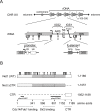The C-terminal region of Net1 is an activator of RNA polymerase I transcription with conserved features from yeast to human
- PMID: 30802237
- PMCID: PMC6415870
- DOI: 10.1371/journal.pgen.1008006
The C-terminal region of Net1 is an activator of RNA polymerase I transcription with conserved features from yeast to human
Abstract
RNA polymerase I (Pol I) synthesizes ribosomal RNA (rRNA) in all eukaryotes, accounting for the major part of transcriptional activity in proliferating cells. Although basal Pol I transcription factors have been characterized in diverse organisms, the molecular basis of the robust rRNA production in vivo remains largely unknown. In S. cerevisiae, the multifunctional Net1 protein was reported to stimulate Pol I transcription. We found that the Pol I-stimulating function can be attributed to the very C-terminal region (CTR) of Net1. The CTR was required for normal cell growth and Pol I recruitment to rRNA genes in vivo and sufficient to promote Pol I transcription in vitro. Similarity with the acidic tail region of mammalian Pol I transcription factor UBF, which could partly functionally substitute for the CTR, suggests conserved roles for CTR-like domains in Pol I transcription from yeast to human.
Conflict of interest statement
The authors have declared that no competing interests exist.
Figures








Similar articles
-
Net1 stimulates RNA polymerase I transcription and regulates nucleolar structure independently of controlling mitotic exit.Mol Cell. 2001 Jul;8(1):45-55. doi: 10.1016/s1097-2765(01)00291-x. Mol Cell. 2001. PMID: 11511359
-
TOR-dependent reduction in the expression level of Rrn3p lowers the activity of the yeast RNA Pol I machinery, but does not account for the strong inhibition of rRNA production.Nucleic Acids Res. 2010 Sep;38(16):5315-26. doi: 10.1093/nar/gkq264. Epub 2010 Apr 25. Nucleic Acids Res. 2010. PMID: 20421203 Free PMC article.
-
Yeast transcription elongation factor Spt5 associates with RNA polymerase I and RNA polymerase II directly.J Biol Chem. 2011 May 27;286(21):18825-33. doi: 10.1074/jbc.M110.202119. Epub 2011 Apr 5. J Biol Chem. 2011. PMID: 21467036 Free PMC article.
-
The RNA polymerase I transcription machinery.Biochem Soc Symp. 2006;(73):203-16. doi: 10.1042/bss0730203. Biochem Soc Symp. 2006. PMID: 16626300 Free PMC article. Review.
-
RNA polymerase I termination: Where is the end?Biochim Biophys Acta. 2013 Mar-Apr;1829(3-4):306-17. doi: 10.1016/j.bbagrm.2012.10.007. Epub 2012 Oct 23. Biochim Biophys Acta. 2013. PMID: 23092677 Review.
Cited by
-
Targeting of Hmo1 to subcompartments of the budding yeast nucleolus.Mol Biol Cell. 2023 Mar 1;34(3):ar22. doi: 10.1091/mbc.E22-07-0261. Epub 2023 Jan 25. Mol Biol Cell. 2023. PMID: 36696177 Free PMC article.
-
New insights into nuclear import and nucleolar localization of yeast RNA exosome subunits.Mol Biol Cell. 2025 Jun 1;36(6):ar69. doi: 10.1091/mbc.E25-02-0078. Epub 2025 Apr 23. Mol Biol Cell. 2025. PMID: 40266794
-
Psoralen Crosslinking-Chromatin Endogenous Cleavage Assay to Examine Histone DNA Interactions of Active and Inactive rRNA Genes.Methods Mol Biol. 2025;2919:133-154. doi: 10.1007/978-1-0716-4486-7_8. Methods Mol Biol. 2025. PMID: 40257561
-
Saccharomyces cerevisiae deficient in the early anaphase release of Cdc14 can traverse anaphase I without ribosomal DNA disjunction and successfully complete meiosis.Biol Open. 2023 Oct 15;12(10):bio059853. doi: 10.1242/bio.059853. Epub 2023 Oct 17. Biol Open. 2023. PMID: 37530060 Free PMC article.
-
Structural basis of RNA polymerase I pre-initiation complex formation and promoter melting.Nat Commun. 2020 Mar 5;11(1):1206. doi: 10.1038/s41467-020-15052-y. Nat Commun. 2020. PMID: 32139698 Free PMC article.
References
-
- Warner JR. The economics of ribosome biosynthesis in yeast. Trends Biochem Sci. 1999. November;24(11):437–40. - PubMed
-
- Boukhgalter B, Liu M, Guo A, Tripp M, Tran K, Huynh C, et al. Characterization of a fission yeast subunit of an RNA polymerase I essential transcription initiation factor, SpRrn7h/TAF(I)68, that bridges yeast and mammals: association with SpRrn11h and the core ribosomal RNA gene promoter. Gene. 2002. May 29;291(1–2):187–201. - PubMed
-
- Keys DA, Vu L, Steffan JS, Dodd JA, Yamamoto RT, Nogi Y, et al. RRN6 and RRN7 encode subunits of a multiprotein complex essential for the initiation of rDNA transcription by RNA polymerase I in Saccharomyces cerevisiae. Genes Dev. 1994. October 1;8(19):2349–62. - PubMed
Publication types
MeSH terms
Substances
LinkOut - more resources
Full Text Sources
Molecular Biology Databases

